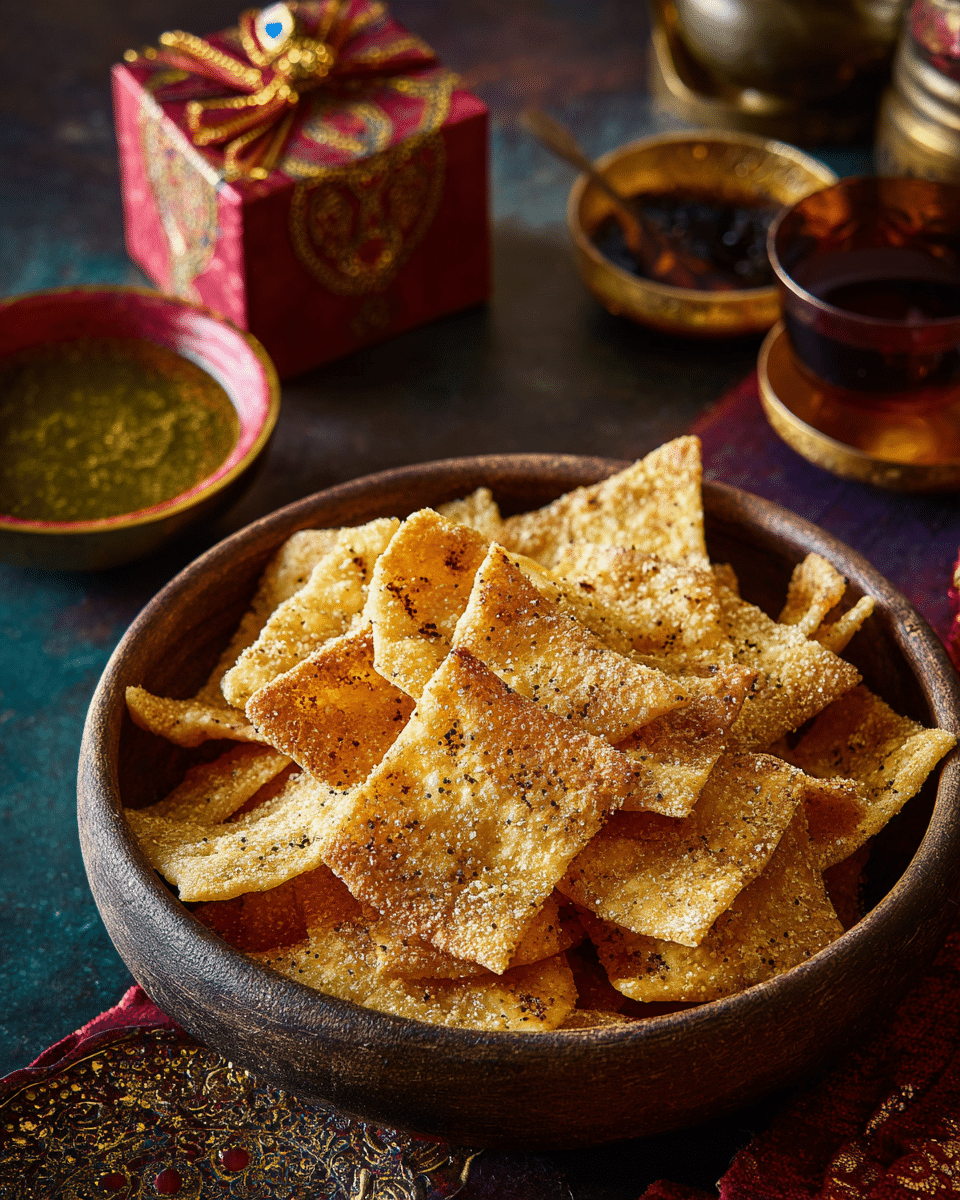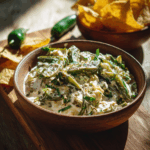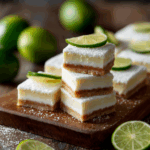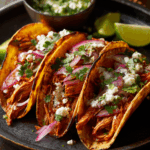Namak Para is a popular Indian savory snack known for its crispy texture and mildly spiced flavor. Often prepared during festivals and special occasions like Raksha Bandhan, this crunchy treat is made from a simple dough of flour, spices, and oil, which is then deep-fried to golden perfection. Namak Para is loved for its portability and long shelf life, making it an ideal snack to serve at gatherings or to pack in lunchboxes.
FULL RECIPE
Ingredients
- 2 cups all-purpose flour (maida)
- 4 tablespoons semolina (sooji)
- 4 tablespoons oil or ghee (for dough)
- 1 teaspoon carom seeds (ajwain)
- 1 teaspoon salt (adjust to taste)
- 1/2 teaspoon black pepper powder
- 1/4 teaspoon turmeric powder (optional)
- Water (as needed to knead the dough)
- Oil (for deep frying)
Directions
- In a large mixing bowl, combine the all-purpose flour, semolina, salt, carom seeds, black pepper, and turmeric powder. Mix well.
- Add the 4 tablespoons of oil or ghee to the dry ingredients and rub it in using your fingers until the mixture resembles coarse crumbs.
- Gradually add water, a little at a time, and knead into a firm but smooth dough. Cover the dough and let it rest for 15-20 minutes.
- Divide the dough into small portions and roll each portion out on a lightly floured surface into a thin sheet, about 1/8 inch thick.
- Using a knife or pizza cutter, cut the rolled dough into small diamond or square shapes.
- Heat oil in a deep frying pan on medium heat. To test if the oil is ready, drop a small piece of dough—if it rises to the surface quickly, the oil is hot enough.
- Fry the cut pieces in batches, stirring gently to ensure even cooking, until they turn golden brown and crispy. Remove with a slotted spoon and drain on paper towels.
- Allow the Namak Para to cool completely before storing them in an airtight container.
Nutrition Facts
- Calories: 180 kcal
- Carbohydrates: 20g
- Protein: 3g
- Fat: 9g
- Saturated Fat: 3g
- Cholesterol: 0mg
- Sodium: 250mg
- Fiber: 1.5g
- Sugar: 0g
Historical Background of Namak Para
Namak Para is a traditional Indian snack that has been enjoyed for generations across many regions of India and Pakistan. Its roots lie in rural kitchens where simple ingredients like flour and spices were transformed into crunchy treats to accompany tea. Especially popular during festivals such as Diwali and Raksha Bandhan, Namak Para symbolizes comfort food that brings families together. Its simplicity and ease of preparation have ensured its continued popularity in both urban and rural households.
Key Ingredients and Their Roles
The core ingredients of Namak Para—flour, semolina, oil, and spices—each contribute uniquely to its texture and flavor. All-purpose flour forms the base, providing structure, while semolina adds a subtle crunch and firmness. Oil or ghee incorporated in the dough lends tenderness and richness, preventing the snack from becoming too hard. The spices such as carom seeds and black pepper infuse a mild savory heat and aroma, creating a well-balanced flavor profile that is mildly spicy and appetizing.
Texture and Flavor Profile
One of the defining features of Namak Para is its perfect crispiness, achieved by rolling the dough thin and frying it in hot oil. The result is a golden, crunchy snack that shatters delightfully with every bite. The flavor is predominantly savory, with a gentle kick from black pepper and a hint of earthiness from carom seeds. The balance of salt and spices makes Namak Para ideal for snacking, satisfying cravings without overwhelming the palate.
Health Considerations
While Namak Para is a delicious snack, it is important to consider its nutritional aspects. Being deep-fried, it is relatively high in fat and calories, which should be consumed in moderation. However, the use of carom seeds offers some digestive benefits, as they are known to aid in digestion and reduce bloating. For those looking to reduce oil intake, baking instead of frying or using healthier oils can make this snack more diet-friendly without compromising much on taste.
Variations Across Regions
Namak Para sees various regional adaptations in India. Some recipes include the addition of spices like cumin or ajwain in different proportions, while others might use whole wheat flour instead of all-purpose flour for a nuttier taste and added fiber. In some households, semolina is omitted or replaced with rice flour for a different texture. Sweet versions of para, sprinkled with sugar or coated in jaggery syrup, also exist, showcasing the snack’s versatility.
Serving Suggestions
Namak Para is commonly served as a teatime snack alongside a hot cup of chai (Indian spiced tea), where its crunchy texture complements the warm beverage perfectly. It can also be enjoyed as a standalone snack during gatherings or packed for travel and picnics. Some people like to pair it with chutneys or dips to add a tangy contrast. Its salty, mildly spiced flavor profile allows it to blend well with both sweet and savory accompaniments.
Storage Tips for Freshness
To maintain the crispness and flavor of Namak Para, proper storage is essential. Once cooled completely, storing the snack in an airtight container prevents moisture from making it soggy. It can be kept at room temperature for up to two weeks without losing its crunch. If stored improperly or exposed to humidity, the para tends to lose its crispiness and may develop an off-flavor, so airtight packaging is key to enjoying it fresh.
Common Mistakes to Avoid
Making perfectly crispy Namak Para requires attention to detail. One frequent mistake is not kneading the dough firm enough, resulting in para that breaks easily or becomes too soft after frying. Another is frying at the wrong oil temperature—if the oil is too hot, the para burns outside but remains raw inside; if too cool, it absorbs excess oil and becomes greasy. Additionally, cutting the dough too thick or unevenly can cause uneven cooking, so rolling it thin and uniform is crucial.
Namak Para in Festive and Everyday Contexts
Though often associated with festivals like Raksha Bandhan and Diwali, Namak Para is a versatile snack enjoyed year-round. Its long shelf life makes it a convenient choice for busy households, and it is often prepared in large batches to share with family and friends. During festive occasions, it is commonly packed in decorative tins and gifted, symbolizing warmth and hospitality. Its presence on snack trays adds to the celebratory spirit and nostalgia.
Advertisement
Modern Twists and Innovations
Contemporary cooks have experimented with Namak Para by incorporating various flavors and healthier ingredients. Some recipes include the addition of herbs like rosemary or oregano for a fusion twist, while others use multigrain flours to enhance nutritional value. Baking the para instead of deep frying has gained popularity among health-conscious individuals. Additionally, flavored salts or spice blends sprinkled on top after frying add an exciting dimension to the traditional recipe.
Conclusion
Namak Para remains a beloved savory snack that combines simplicity with irresistible crunch and flavor. Its rich history and cultural significance, combined with easy preparation and long shelf life, make it a staple in Indian households and festive celebrations like Raksha Bandhan. Whether enjoyed as a comforting teatime treat or shared during joyous occasions, Namak Para continues to bring people together through its timeless appeal. Its adaptability to new variations and health-conscious modifications ensures that this traditional snack will be enjoyed for many more generations to come.






